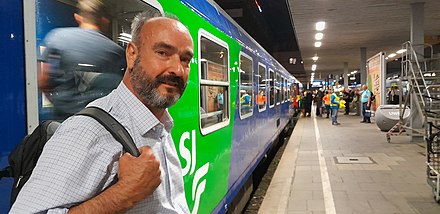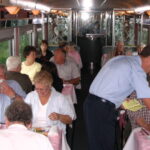The Long, Long, Short and Long of it.
This is one of the really curious things about railroading . . . at least in the United States.
First let me explain that when a train approaches one of the many thousand places where a road crosses the railroad tracks “at grade”—that is, where the automobile traffic drives right over the railroad tracks—it is mandatory for the engineer to warn any cars about to cross the tracks with the train’s whistle.
But—and this is what I find so interesting—engineers, whether they are working for Amtrak or for one of the freight railroads, are all instructed to use a very specific whistle pattern when approaching a grade crossing: long, long, short, long. As an engineer told me, “It’s very specific. It’s in the manuals.”
The question I had—now quite a few years ago—was why was that specific combination of long and short blasts on the whistle required by all railroads in North America?
Nobody knew!
There was a time when I asked every conductor on every train ride, and the response was a shrug and the inevitable “Because it’s in the manual.”

And then I mentioned it to Mark Smith. He lives in a suburb of London and is the man behind the world’s best train travel web site, The Man in Seat Sixty-One.
“Well,” he said, “long-long-short-long is Morse Code for the letter Q, so one possible explanation could be that when Queen Victoria went somewhere on the royal yacht, it’s captain blew long-long-short-long on the horn which meant ‘The Queen is on board … Get the hell out of the way!’ ”
That’s the only explanation I’ve ever gotten and it doesn’t explain why trains in the UK don’t use that signal. The fact remains, however, it is the only explanation I’ve ever heard.
By the way, here’s a link to Mark Smith’s web site, but I warn you all in advance that it’s addictive. And, since everyone always asks, apparently seat 61 is Mark Smith’s preferred seat on the Eurostar train to Paris.
Personally, I don’t care what seat I’m in as long as I’m on my way to Paris at 187 miles-per-hour!




I don’t buy it. The first use of something like the 14-L is in a late nineteenth century Eastern Railroad (of Massachusetts) rule book, where the road crossing signal was long-long-short-short (and that lasted in Boston and Maine rule books into the 1950s.)
It might have lasted longer on the B&M because the Commonwealth of Massachusetts set a ten second limit on the length of a train whistle signal.
The final long probably emerged because it’s easier to hold on to the signal until the engine reaches the crossing if it’s a prolonged long … a ferroequinological fermata if you will, rather than having to time your first long so as to crack that short off right at the crossing. Note that contemporary rule books request the signal be repeated or held until the engine hits the crossing, which would no doubt drive Massachusetts constables nuts.
When did International Morse become a thing, anyway? Queen Victoria passed early in the twentieth century.
That’s the fun of this . . .every answer has the potential of being the right one.